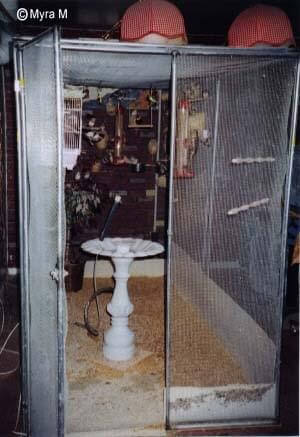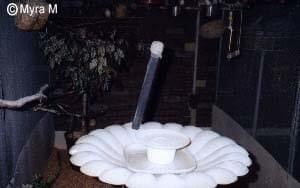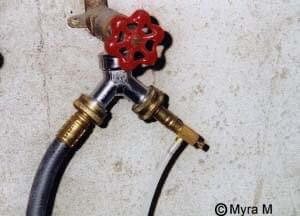You wouldn't know it now, but like most people I started out with a single bird, a male zebra finch. It wasn't more than a month later when I decided I'd like to buy a female for him.. Two birds quickly became four, then six, and so on. Many years later I have a flock of around 80 finches.
 Myra Markley (FinchNiche) photo of Aviary Myra Markley (FinchNiche) photo of Aviary
I started out with a cage for each pair but after my flock grew to 8 pairs I realized I was running out of space to put cages. I also found that I was spending a lot more time cleaning cages and changing food and water for the birds than I liked.
I tried buying a few large cages for my pairs to share. That led to some fighting, though nothing serious, only a few plucked feathers. At the time I really had no idea what size a cage should be used to house a few pairs of finches, but now I know the flights were small and that I had some very aggressive females.
After talking with other local finch breeders, I decided to try an aviary. This aviary would allow my finches plenty of room and fulfill my one greatest wish; to be able to stand amongst my finch friends.
The reality of the cost set in. One small walk-in aviary could cost from $500-$1000. I don't breed birds for a living, and there was no way I could afford that so I talked the design over with my father and uncle and they agreed to help.
My homebuilt aviary cost about $250. It was built over a period of 2 weekends and assembled in my basement [because that was the only place it would fit, and it allows me to give the birds proper lighting]. It stands 5'5' tall [I'm a short gal, I have no problem standing up in this aviary], it's 4' wide and 8' long. I use hanging bird feeders for their seed, and a small fountain that supplies fresh water constantly. I also installed large removable bowls [the kind you buy for T-Stands and Parrot Cages] to hold the fruits, veggies, egg, and other treats.
<
If you are interested in building one of your own feel free to use my design as a guide:
Flight area building supplies:
- 17 - 10' sections of 1/2" thin wall Electrical Conduit
- 1 - 50' roll of 1/4" hardware cloth
- 34 - 2" #8-32 steel machine screws and nuts
- 100 - 1/2" #8 PH wafer k-lath screws
- 2 - small hinges
- 1 - door latch
- 1 - 4x8 foot sheet of plywood
- 1 - 4x8 foot panel of slick surfaced masonite
- 1 - latch or locking mechanism
|
Fountain -
The fountain has gone through two phases.. It started out as a large bucket of water and a small pump that circulated water. The water ran over two small plates and drained back into the bucket through a few small holes. This, however, required someone to change the water in the bucket everyday.
 Water Fount - How to Build and Aviary by Myra Markley Water Fount - How to Build and Aviary by Myra Markley
Finally my father and I redesigned it to constantly have fresh water running into the aviary. This is really a kludge but it does work very well for me.
First we needed some tubing. One hose is a food grade polypropylene tube that runs the water from the house to the aviary. I used the food grade tube because it won't rot or break down and poison my birds. I also used a larger polyethylene tube to run from the fountain to the drain in the basement floor. It doesn't really matter what you use for the second tube as long as it's big enough that the seed and droppings won't clog it up.
 Water - How to build an Aviary by Myra Markley Water - How to build an Aviary by Myra Markley
To adjust the amount of water flow into the aviary we used a needle valve. This valve isn't something you can find at your local hardware store unfortunately. I acquired mine through my uncle. From what he has told me, it came out of an old 8-track winding assembly machine. It does work very well tho. Just the slightest turn will adjust the flow of water from a few drips a second to a steady stream.
The fountain itself is just a bird bath. I bought it at the hardware store when I picked up the tubing. A few old plates and a drain finish it off. [see photo]
The best advice I can give you is to experiment, be creative. As you can see by mine, aviaries don't have to cost a small fortune to build. |